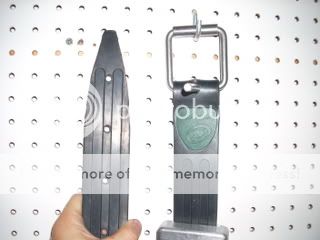Sorry that they were difficult to install at first, but I like your solution. Was the belt getting hung up because of the thickness, or the width? By that, I mean did you have the edges tapered like this:

If not, then that's obviously easy to fix. You are right in that it is almost impossible to thread the weights if the belt does not protrude through the slot enough to get a good grip. If you were finding that your belt was too thick for the weight slot, then I need to adjust the dimension to better accomodate the RA belt. I check every weight to make sure that it fits easily on my RA belt, but this makes me wonder if maybe the thickness of the belts varies somewhat from one to the other?
One other thing that I should mention for anyone else who may have trouble. It is very hard to hold the weight in one hand and pull the belt through with the other. It works much easier if you put the belt on the floor. Step on the buckle end, and pull the free end to stretch the belt. THEN slide the weight. You probably already figured that out, but it isn't always obvious to someone else just looking at the pictures.

